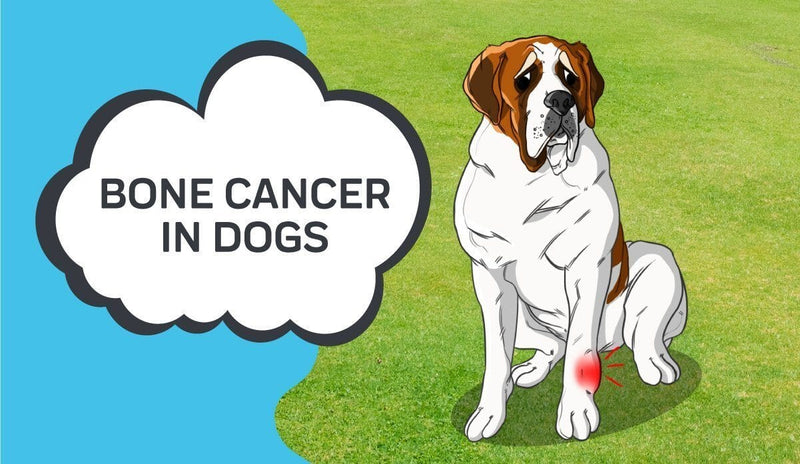- Lung Cancer in Dogs
- Symptoms of Lung Cancer in Dogs
- Types of Canine Lung Cancer
- How Lung Cancer is Diagnosed
- Treatments
- How Long Will My Dog Live?
Lung cancer is a serious disease that places both the health and well-being of dogs at serious risk. The goal is to spot the clinical signs of lung cancer in dogs as soon as possible to give your pet the best chance of survival.
Like most forms of cancer, older dogs are more likely to develop lung cancer - usually at ten years old or more. It’s also been found that Boxer dogs have an increased risk of developing lung adenocarcinoma (cancerous tumors) than other breeds; although this disease can affect all dog breeds.
Let’s first look at the various symptoms and stages of lung cancer in dogs. Then, we’ll look more closely at the five main types of this type of cancer, as well as how to move forward once a diagnosis is received.
Lung Cancer in Dogs
Veterinarians have been noticing an increase in the number of pets diagnosed with lung cancer over the last 20 years. While it is unclear what exactly has led to this spike, a potential explanation could be that dogs are living longer than they used to - as older animals tend to contract the disease more often. Another possible cause might be improved diagnostics and awareness about its existence, or high levels of carcinogens found around us every day could also contribute towards these cases being seen so much more frequently now compared with before.
Symptoms of Lung Cancer in Dogs

Primary Lung cancer is a progressive disease, meaning it gets worse over time. Unlike some other types of cancer, there are some concerning symptoms that arise in the earlier stages of primary lung cancer for dogs that should immediately alert you that something is wrong. However, you might not notice signs for some time, compared with squamous cell cancer types (e.g. skin cancer) that are immediately apparent.
As the disease progresses, the symptoms intensify and the need for medical attention increases overnight. The clinical signs are indicative of the lung cancer stage a dog is in, and these stages are…
- Early stage
- Middle stage
- Late stage
- Crisis mode
Early Stage Symptoms
- Coughing up blood
- Chronic Cough
- Accumulation of mucus in the throat
- Unable to keep food down
- Rapid weight loss
- Total loss of appetite
- Difficulty making motor movements
- Difficulty inhaling
- Heavy yet shallow breathing
Middle Stage Symptoms
- No interest in anything around them
- Exhaustion
- Constantly trying to sleep - but difficulty in falling asleep and staying asleep
- Concerning weight loss
- Shortness of breath and respiratory signs
- Difficulty breathing through the nose
- Restless and fidgety
- Excessive thirst, panting and rapid breathing
Late Stage Symptoms
- Preferring to be alone
- Limp limbs and weakness
- Nausea and vomiting
- Zero appetite whatsoever
- Frequent diarrhea
Crisis Stage Symptoms
- Epilepsy-like behavior
- Seizures that persist
- Inability to control bladder
- Incapable of keeping food down
- Difficulty walking around
- Purple tongue or blue gums/lips
- Struggling to breathe
- Fainting at random
Types of Canine Lung Cancer
There are five main types, which are:
- Epithelial Lung Tumors
- Larynx and Tracheal Tumors
- Metastatic Lung Tumors
- Nasal and Sinus Tumors
- Primary Lung Tumors
Now, let’s explore the two primary types in more depth. The two most common types in dogs are caused by epithelial lung tumors and primary lung tumors.
Epithelial Lung Tumors
One of the types of tumors are called epithelial lung tumors. Medically referred to as adenocarcinoma, this type of lung tumor is a prominent primary lung condition that accounts for three-quarters of all canine lung cancer diagnoses.
Adenocarcinoma tumors in dogs start out as abnormal growths in the epithelial lung tissue layer. This will only go away if surgically removed, followed by consistent radiation therapy.
Your dog's lung cancer specialists will determine the appropriate amount of time and the number of radiation therapy appointments your dog should undergo. The entirety of the epithelial lung tumor will be removed by surgeons, so radiation will be a follow-up measure for killing off any remaining cancerous cells in your dog’s epithelial tissue.
An adenocarcinoma lung tumor is malignant, so not only does it increase in size very quickly, but it is likely to become metastatic lung cancer . This occurs when cancerous cells travel around the body and new tumors form elsewhere. Usually, this infects the liver of dogs and then exits to move to other internal organs.
Primary Lung Tumors
Primary lung cancer can take place in any part of the lobes of lung tissue. In the lungs of dogs, the number and type of lung lobes are different on each side. To the right, there are four different lobes, including the accessory, caudal, cranial, and middle lobes. To the left, canine lung lobes include only two lobes, which are the caudal and the middle lobes.
Primary lung tumors can become larger metastatic lung tumors, causing them to spread to other parts of the body. This is why primary lung tumors are so daunting. Primary lung cancers are the most concerning because not only do they have the potential to metastasize, but they can occur in any part of the lungs.
How Lung Cancer is Diagnosed
First, it’s down to you as a dog owner to pick up on any unusual behavior by your pet. If you notice changes in their eating, breathing, or general demeanor that is out of character, you should consider taking them to the vet for a health check - it’s best to be safe than sorry. If your dog is exhibiting any of the more worrying signs, like coughing up blood or persistent vomiting, contact an emergency vet as soon as possible.

When it comes to diagnosing lung cancer in dogs, the most helpful tool utilized by canine cancer specialists is something known as a thoracic radiograph. It's essentially a radiology tool for the chest cavity, which gives specialists an inside look at the lungs of dogs.
After the thoracic radiograph test is conducted, an additional exam will likely be done as well in order to double-check the findings of the thoracic chest radiograph results. That's where the possibility of a CT scan, an MRI, or an abdominal ultrasound come into play.
After an analysis of your dog’s health history is complete, the canine lung cancer specialists can move onto figuring out which treatment options are best for your dog’s diagnosis of lung cancer. There are so many treatment options to choose from, including but not always limited to…
- Complete blood count exam
- Computed tomography scans, or CT scan
- Magnetic resonance imaging exams, or MRI
- Other forms of blood work as deemed fit
- Ultrasonography tests
- Fine needle biopsies
A fine needle biopsy is where cells from the tumor are collected with a long, thin needle that is inserted through the surface of the skin and all the way down into the tumor. It will then remove cells or fluid which are then tested to determine whether it is cancerous or not. This can be used on all forms of cancer, including squamous cell types.
Though an abdominal ultrasound has its own set of beneficial elements, most canine lung cancer specialists will opt for either a CT scan or an MRI. The reason for the preference of CT scans and MRI tests over ultrasonographic examinations is that the first two enable doctors to check for a potential malignancy of most primary lung tumors.
If tumors in dogs are malignant, they can become metastatic, thereby causing the spread of cancer from the lungs to other parts of the body. Cancer that spreads elsewhere becomes far more difficult to treat, primarily because it enters the lymph nodes. When cancerous cells enact the lymph node involvement, they can travel by way of the lymph nodes through the lymphatic system. As a result of this possibility, metastatic disease to the lymph nodes is something cancer specialists are eager to avoid.
Treatments
If your dog has lung cancer, it may be recommended by the veterinarian to surgically remove the tumor from its lungs. This is a successful procedure for most dogs and they return home shortly afterward without any complications. If surgery does not work because of location or spread, chemotherapy also known as radiation therapy will likely be prescribed as an alternative treatment option in order to keep them healthy until their death comes naturally or with further medical intervention.
Primary lung cancer treatment options are similar yet different to the ways that other forms of canine cancer are treated. First of all, surgical removal is the most straightforward way of eliminating the cancerous cells because it is a way of literally removing the single primary lung tumor.

Alongside medical treatment, other forms of pain management can be considered, such as the use of CBD oil for dogs. Your vet will be able to recommend dosages and the best form of administering the supplement for your pet. CBD oil cannot cure any disease, but can improve a dog’s quality of sleep, sense of wellbeing, relaxation, and can ease their pain. Many pet owners choose to administer CBD oil to their dogs to calm them when they’re in discomfort.
How Long Will My Dog Live?
The average survival time fully depends on the type of tumor as well as the size of the mass in a dog's lungs. When tumors are in the early stage, can undergo surgical removal, and have not even come close to spreading elsewhere in the body, dogs are expected to live for roughly twenty months.
Lung Cancer in dogs at the intermediate stage poses more of a threat to their recovery rate, but it’s nowhere near as low as the prognosis of dogs in crisis mode. At this point, if the cancerous tumor is large but the cancerous cells have not become metastatic tumors, then dogs often live for about eight months or so.
When the tumors have grown in size and made their way into the lymph nodes of your dog’s lymphatic system, the prognosis is far lower, with the average survival time coming in at about two months. The main reason for this is the element of metastasis because once lung tumors spread throughout the body, it increases the difficulty of treating the cancer overall.
In late stage cases, dogs usually do not have an expected survival time of longer than one month after receiving a diagnosis of lung cancer. As always, early detection is a saving grace and the best way to increase the dog’s chances of survival is catching it sooner than later. However, at any stage of diagnosis, the survival time once a dog has lung cancer is unfortunately, usually, only a maximum of twelve months.
Sources:
Lung Cancer (Adenocarcinoma) in DogsSquamous Cell Cancer
The bronchial tree and lobular division of the dog lung
Lung Cancer in Dogs and Cats
When a Pet is Suffering from Cancer
Cancers and Tumors of the Lung and Airway in Dogs
Lung Tumors in Dogs
Approved by:
Dr. Ivana Vukasinovic
Doctor of Veterinary Medicine, University of Belgrade
 Ivana Vukasinovic grew up in Serbia and attended the University of Belgrade where she received a degree in Veterinary medicine in 2012 and later completed surgical residency working mostly with livestock. Her first year of practice was split between busy small animal practice and emergency clinic, and after two more years of treating many different species of animals, she opened her own veterinary pharmacy where an interest in canine and feline nutrition emerged with an accent on fighting animal obesity. In her free time, she acts as a foster parent for stray animals before their adoption, likes to read SF books and making salted caramel cookies.
Ivana Vukasinovic grew up in Serbia and attended the University of Belgrade where she received a degree in Veterinary medicine in 2012 and later completed surgical residency working mostly with livestock. Her first year of practice was split between busy small animal practice and emergency clinic, and after two more years of treating many different species of animals, she opened her own veterinary pharmacy where an interest in canine and feline nutrition emerged with an accent on fighting animal obesity. In her free time, she acts as a foster parent for stray animals before their adoption, likes to read SF books and making salted caramel cookies.
Thanks for stopping by!
P.S. We Love You!
Sincerely,
The Innovet Team
Please do not ask for emergency or specific medical questions about your pets in the comments. Innovet Pet Products is unable to provide you with specific medical advice or counseling. A detailed physical exam, patient history, and an established veterinarian are required to provide specific medical advice. If you are worried that your pet requires emergency attention or if you have specific medical questions related to your pet’s current or chronic health conditions, please contact or visit your local/preferred veterinarian, an animal-specific poison control hotline, or your local emergency veterinary care center.
Please share your experiences and stories, your opinions and feedback about this blog, or what you've learned that you'd like to share with others.
















